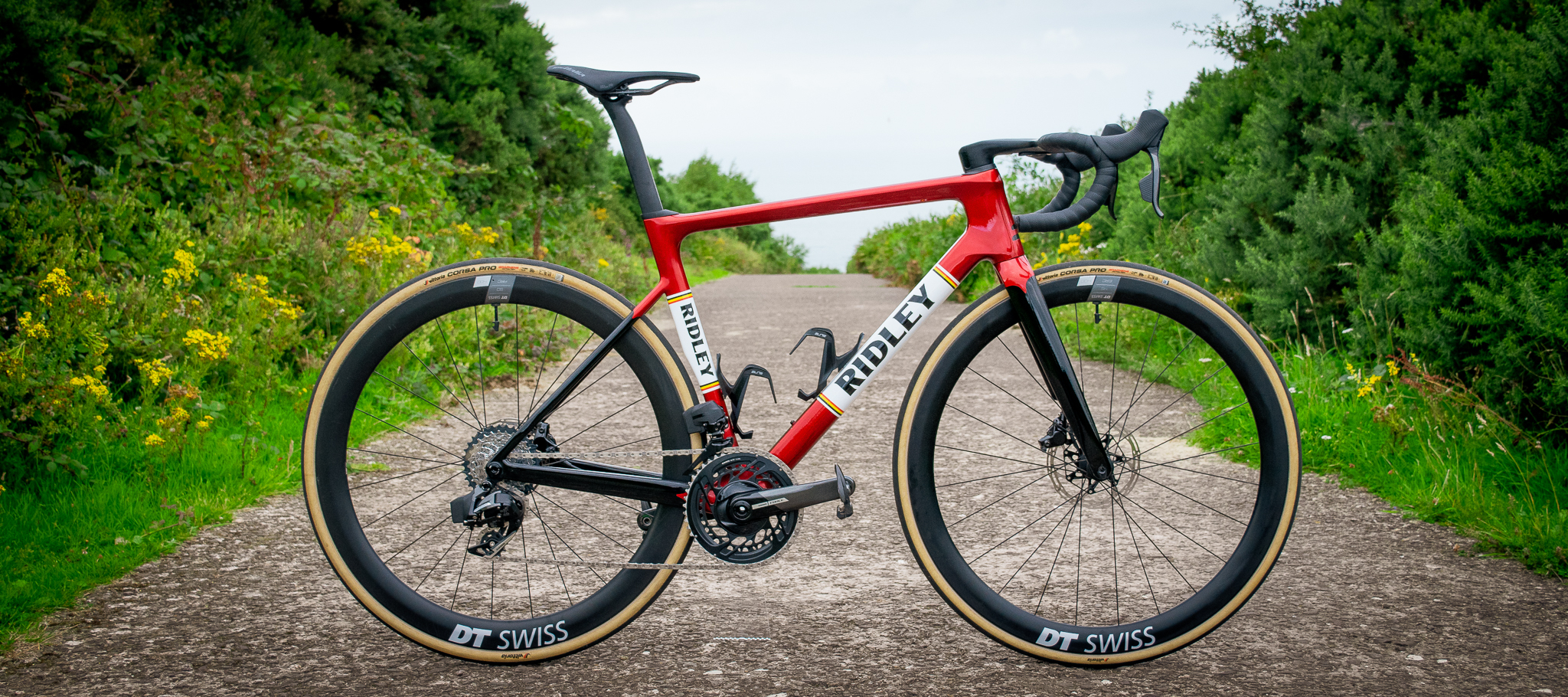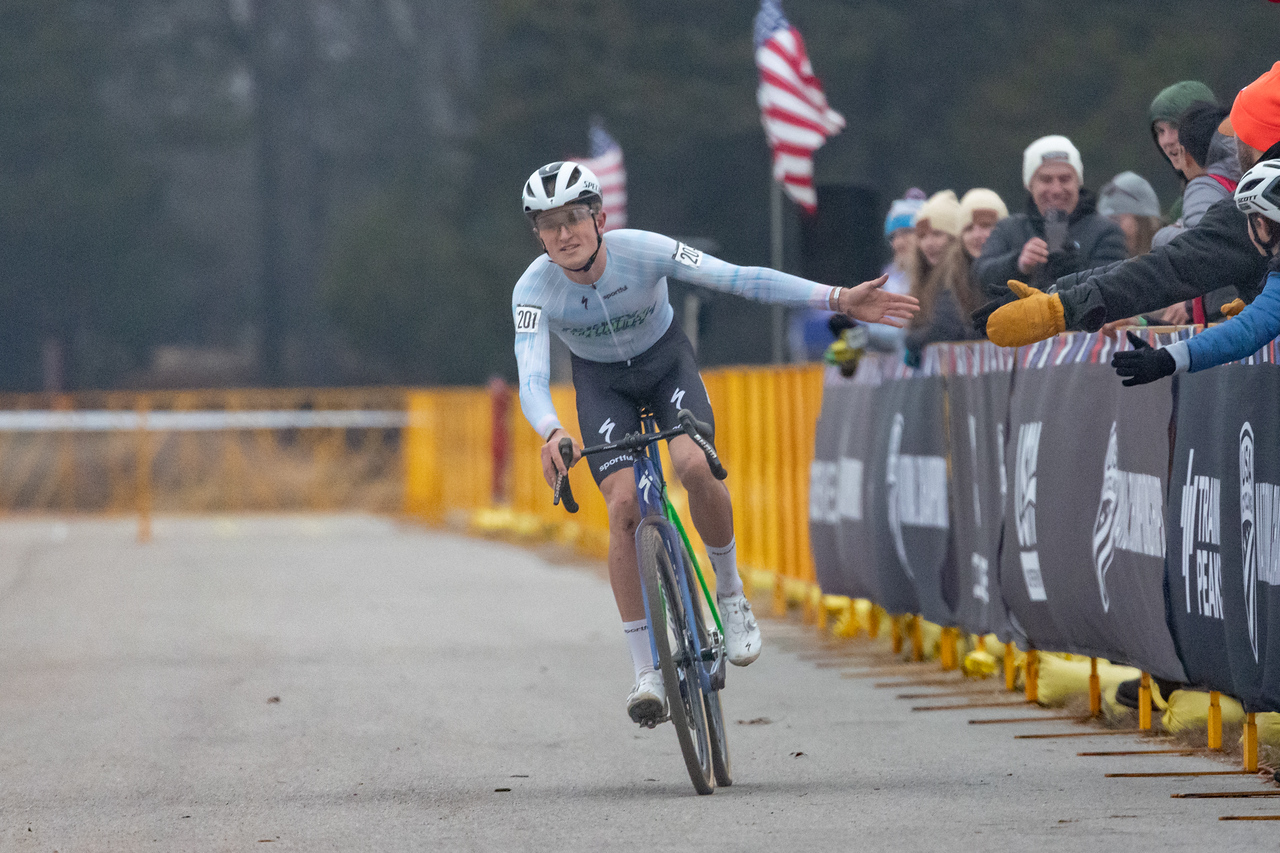Cyclingnews Verdict
The Falcn is a fast, comfortable all-rounder that whilst being undeniably a race bike will handle most things really well
Pros
- +
Stable, confidence-inspiring handling
- +
Carries speed really well on flat and rolling terrain
- +
Range of custom paint options
Cons
- -
No power meter included
- -
No narrower handlebar sizes for 100mm stem lengths and above
You can trust Cyclingnews
This week Ridley announced the launch of its new Falcn RS race bike. Despite some rumours as well as prototypes being spotted earlier in the year, the Falcn has now landed officially. You can also head to our Falcn news story to read up on the bike's release news, but here, we'll focus on our experience with the bike.
I've been able to test-ride a Falcn for the last few months, and even attended the bike's press launch in Italy earlier in this year, so have a pretty thorough understanding of how it rides, where it excels, and perhaps more importantly, where it doesn't.
The Ridley performance road line currently consists of the all-out aero race bike the Noah Fast, the lighter-weight Helium model, and the Fenix endurance model. The Falcn will slot into the range between the Helium and Noah and bridge the gap between lightweight and aero.
It's no secret we've already seen the days of the all-out, no-compromise aero bike fade a little with race bikes now aiming for a blend of aero, lightweight and overall performance. Things seem to have been going in this direction over the last several years now, with many brands moving away from the all-out, at times overbuilt and slightly heavier aero race bike in favour of bikes that are easier to live with across a wider range of terrain.
Or as Ridley puts it: a focus on 'aero to weight'. The Falcn looks to be Ridley's way of slotting another option into its road arsenal that, put simply, utilises the aero performance of the Noah but paired with the lighter weight benefits of the Helium.
I have ridden the Falcn in two different guises: around Como in Italy over a period of three days running a Shimano setup and then for a couple of months here in the UK with a SRAM Force AXS groupset. It's billed as an all round performance road bike and I tried to test it across as wide a range of conditions as I could during that time. Keep reading to find my thoughts below.
Price (as per review spec) : €9399 / £8599 / $12.399
Weight: 7.4kg
Models available: Three
Sizes available: XXS-XL
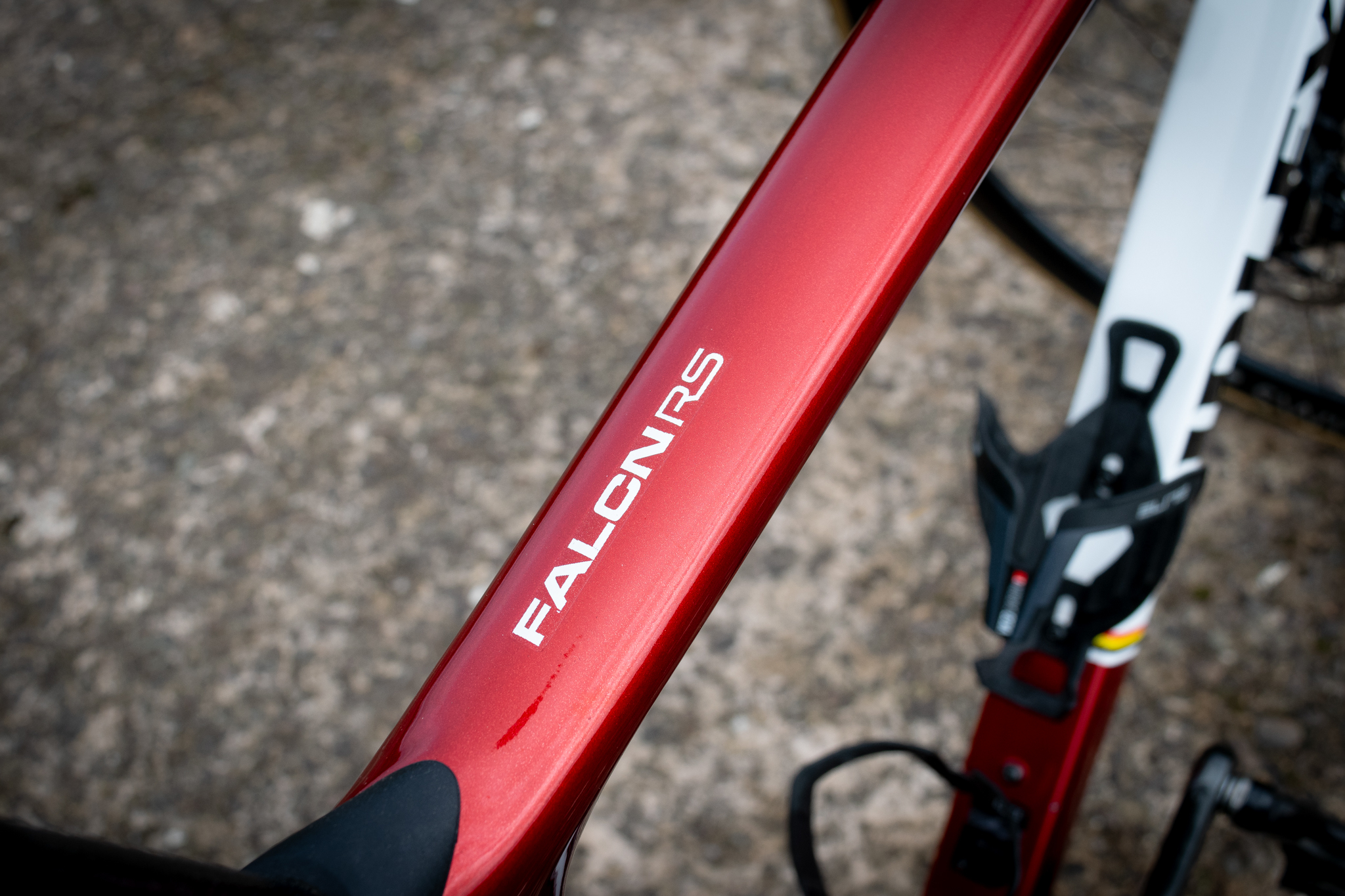
Design and Specification
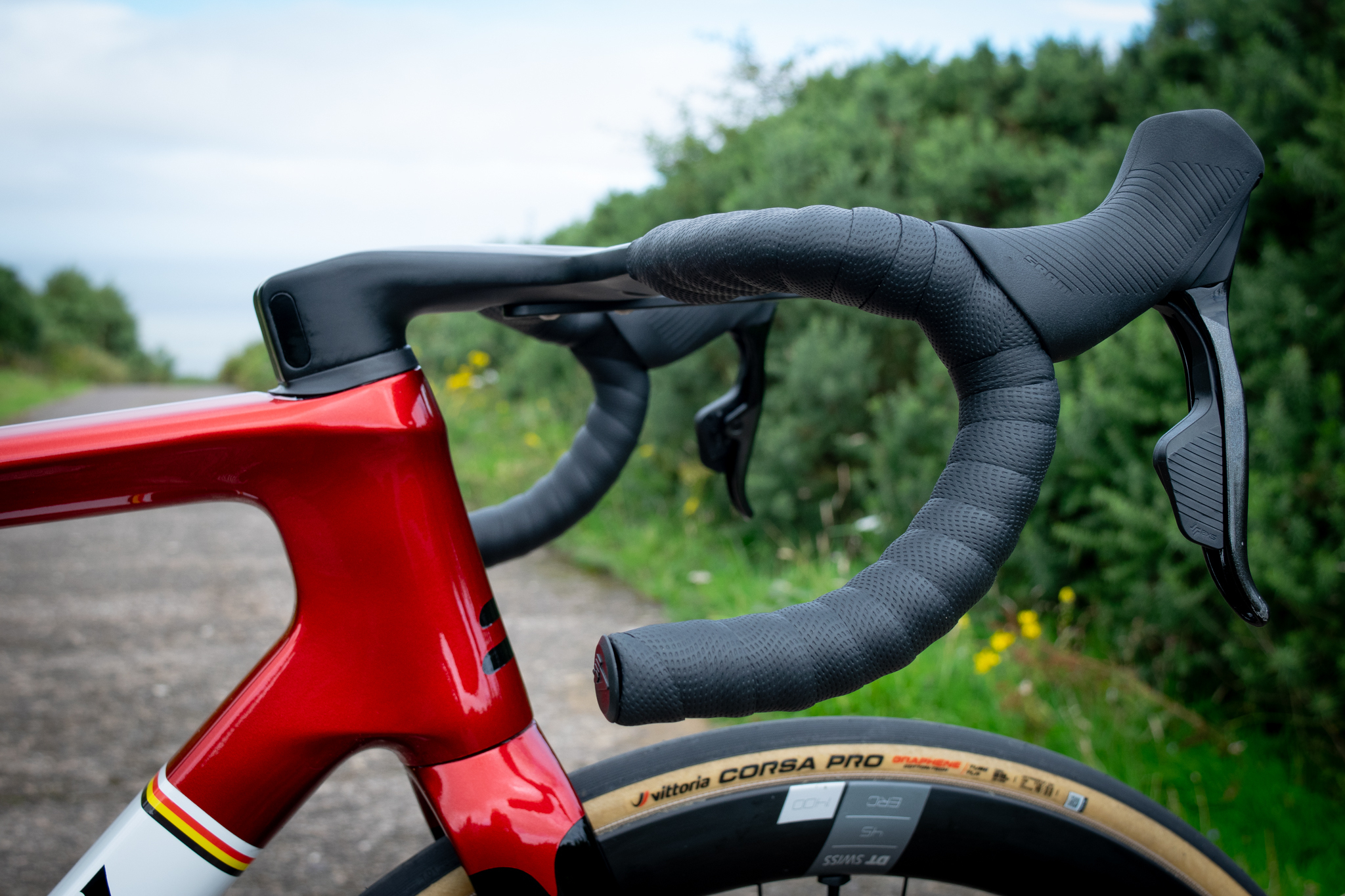
Straight out of the gate, as per its billing, the Falcn does look to blend elements of the Helium and Noah's designs. Like its two stablemates, the Falcn features dropped seat stays, and while its tube profiles are for the most part a little deeper and more aggressive looking than the more classic looking Helium, it doesn't feature the same aggressive aero head tube and fork crown not to mention extra material as the Noah.
The latest race content, interviews, features, reviews and expert buying guides, direct to your inbox!
A medium frame is quoted as coming in at 825 grams, which puts the Falcn around 110 grams heavier than a Helium SLX frame in an equivalent size with a medium bike coming in at around 7.4kg. The aero advantages of the Falcn should mean it's the faster bike overall on everything under around 8% of incline.
The front end is where the aero focus has been employed the most with attention paid to the aero fork crown which acts as a diffuser, and headtube area. Elsewhere, a balance has been sought between aero and lightweight and the frame tubes all flow quite nicely together.
The design features of the bikes are all pretty no-nonsense and there isn't much out of the ordinary here spec-wise. The carbon fibre frame uses a BB86 press-fit bottom bracket, 1 1/8" upper and 1 1/2" lower headset bearings, with a D-shaped steerer tube, Ridley also told me they choose not to add a hole in the steerer tube for a brake hose which is common on some forks. Finally, there are fully integrated brake hoses and flat-mount disc brake mounts.
Ridley has also chosen to spec a SRAM UDH rear derailleur hanger like the new Dean TT bike. Whilst up front there's a removable front derailleur mount if you want to do your best Victor Campenaerts bike setup impression and run a 1x setup. There are also a couple of different mounting points for bottle cages on the seat- and down tubes so customers can choose their position, the lower being the more aero.
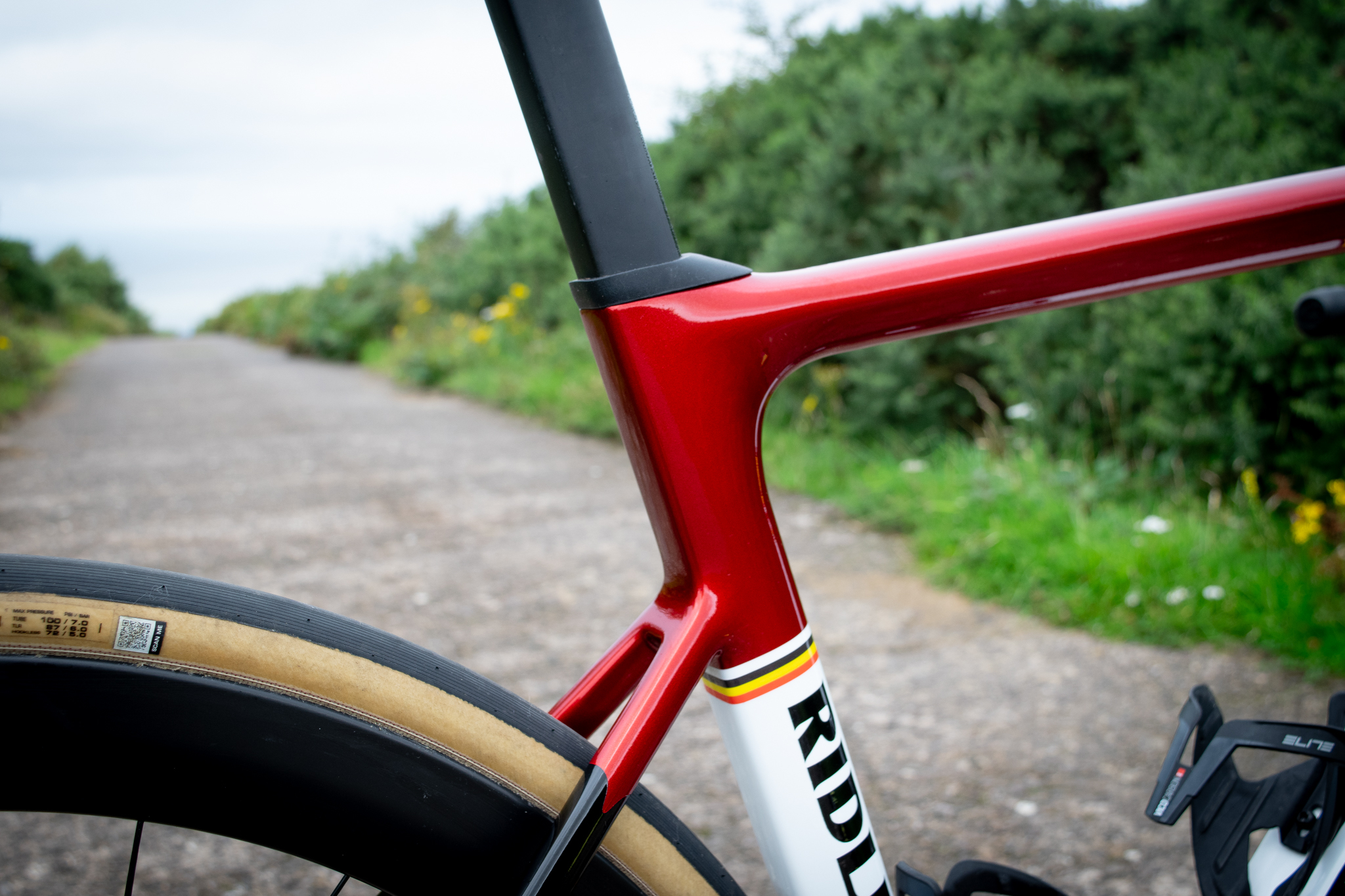
The Falcn also receives new geometry compared to the Noah and Helium, including longer chainstays, a lower bottom bracket, less stack and more reach for a more racy overall platform. This should on paper point to a more aggressive, performance focused ride and some added stability too.
Ridley offers a full paint customisation programme via it's website and paints over 250 frames a day. There are a wide range of paint options available and around 35 base colours to choose from. My UK bike had the classic looking 'heritage' paint scheme you can see in the photos and it garnered a few compliments from other riders while I had the bike.
Spec wise, the Falcn is available with SRAM Force AXS, Shimano Ultegra Di2 or Shimano 105 Di2. The SRAM build gets 48/35T x 10-33T gearing whilst the Ultegra has a 52/36T x 11-30T setup. The Force and Ultegra builds both feature DT Swiss ARC 1400 wheels with DT 240 hubs, Forza Cirrus Pro integrated handlebar and stem, Forza aero seatpost topped with a SLR boot saddle and finally Vittoria Corsa Pro tyres. On the subject of tyres, bikes will come specced with 28mm front and 30mm rear tyres with max clearance for up to 34mm, which puts it in the in the same ball park clearance wise as the Endurance focused Canyon Endurace CFR I rode recently.
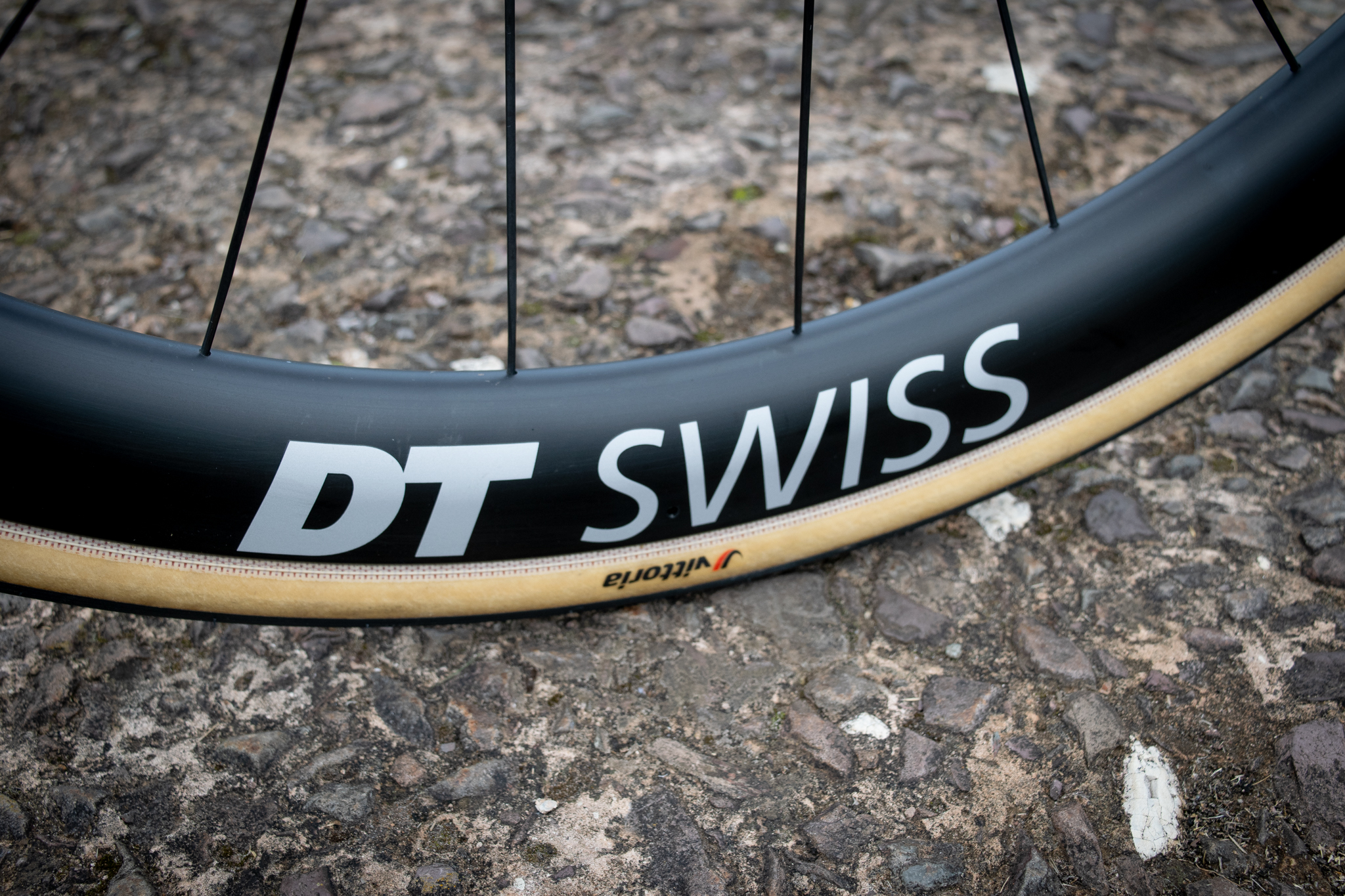
Performance
I've covered just over 500 miles on the Falcn. 400 on my test bike in the UK and around 110 at the bike launch in Italy near Como. My first ride with the bike was just over an hour on the fast and busy roads heading towards Lake Como. The Falcn felt fast and the posistion was slightly longer than what I run myself which just stretched me out a bit more and encouraged me to hunker down and push on.
Perhaps a signal of what the bike is about and Ridley's intent for it, was the completely slammed handlebar the bike arrived with back home in the UK, my test bike in Italy had a 5mm spacer under the stem, while my long-term test bike had nothing but the headset bearing cover. I have to say I kind of liked this, as it's very common for brands to send review bikes with the full complement of spacers still in situ to preserve the resale value once we're finished with it. I fully accept that choice, but it can significantly dull the ride feel of racier bikes. It felt like Ridley saying "it's a race bike, it's not coming with 30mm of spacers" so no huge steerer tube stack to mess with here.
In my opinion, the Falcn climbs really well, and at no point did I think it was holding me back on climbs. The frame's stiff with racy geometry which suits me well enough, add fast wheels and tyres to the mix and your going to feel alright on the climbs. In Italy, I climbed the Madonna del Ghisallo and worked hard, clinging to the back wheel of Ridley rep and ex-pro rider Davide Malacarne. He probably could have left me behind whenever he wanted but kindly let me stay on his wheel. In the UK my hilliest day out on the bike featured over 5000 ft of elevation in under 100km, so there was plenty of up and down to test the bike.
The Falcn tackled all of the climbing really well, the frame felt stiff out of the saddle and the bike just allowed me to get on with the job at hand. I was glad of the lower SRAM gear ratios on some of the tough climbs on Exmoor and the Devon coast though.
In the handling department, I found the Ridley to be solid. Overall I would call the handling confidence inspiring and predictable. Pretty much from the off I felt I could trust the bike and put it wherever I wanted, on my own or nailing corners in a group. It doesn't feel too fast or excitable, more steady and stable. It's certainly not boring and I enjoyed descending and setting up for corners on the Falcn.
I should mention the tyres whilst talking about handling and cornering. This was my first time riding the relatively new Corsa Pro tyres and I couldn't help thinking to myself, "these tyres have just won the Tour de France (or helped to win it), if you are having issues with grip or handling at any point, it's not them it's you." It's something of a placebo effect that instils confidence, and perhaps as a result, I never had any issues.
They even proved to be surprisingly durable. Although they're becoming just as popular as the older Graphene 2.0 tyres, I've long considered them really more of a race-specific, lightweight option that wears and cuts up pretty quickly. But after 500 miles with some pretty rough and wet typical British road surfaces, they were still looking as-new. I had no punctures and no sealant leaks as far as I could see.
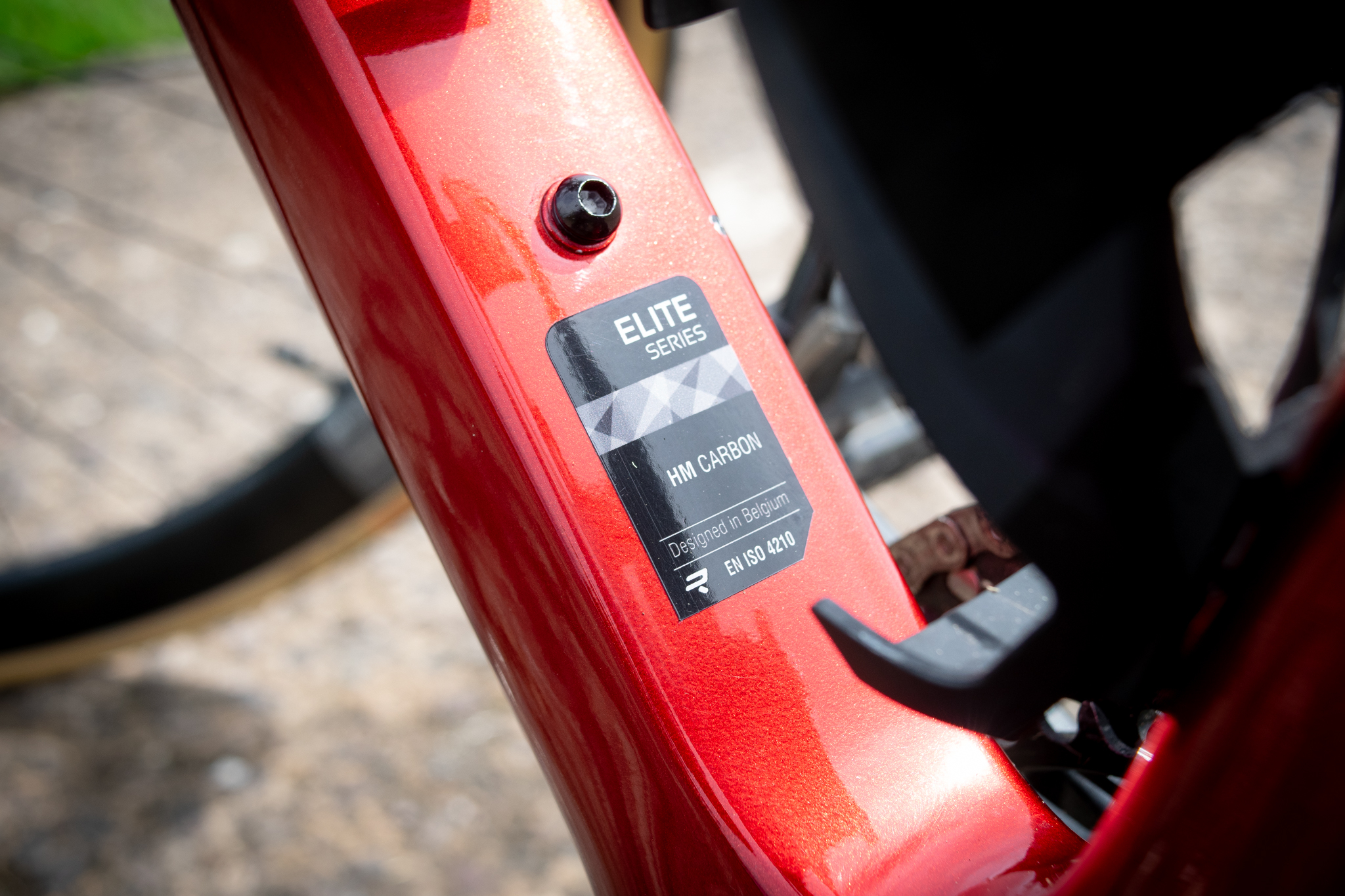
Aside from Exmoor climbing missions, I did a fair few hard rides on the Falcn. This includes a few hard local club runs and chaingangs and I think where the Falcn really shines is on flat and undulating terrain.
The Falcn carries and maintains speed really well on the flat. I think this is probably what it's best at. Hooked into the hoods in an aero position it really does feel like a quick bike. I'd tick a stretch of undulating road off and think 'wow I was really moving there'. The Falcn just covers ground well. Breaking that down, the tyres, my contact point with the ground are some of the fastest around, which undoubtedly helps. But the frame itself, wheels and aero handlebar will also all aid this. Once you are up to speed the bike really feels like it maintains it well and it feels easy to keep your momentum going.
I would have liked a slightly narrower handlebar, my test bikes came with a 400mm bar but it felt on the wider side to me (bars tend to be measured differently). A sub 400mm option would be nice, I appreciate manufacturers can't make unlimited bar sizes but a narrower option would be good to see. Coming from my own 38's it felt wide and took me some getting used to. There's no stock power meter either which would be a desired upgrade for performance riders or racers, it would be nice to get one from the off but there's nothing stopping you from adding one in down the line, it's just a bit more cash to have to drop.
If I lived in a hilly area I'd consider the SRAM setup with the lower gear ratios which really make life easier. But generally, the 52/36 chainset of the Shimano-equipped model would be my preference. I also experienced several chain drops at home with the Sram front derailleur. I think racers are going to want that bigger 52 ring to turn over and the 11T sprocket creates a little less drag than the 10.
There were zero issues with the bike during the whole of my UK testing. Potential niggle areas such as the seat clamp wedge or bottom bracket for instance were silent and hassle-free. The sturdy seatpost wedge also takes a 5mm hex key, the larger size bolt is just that little bit sturdier and should stand up a bit better to any ham-fisted adjustment efforts over time. It just adds to the no-nonsense, functional Ridley feel and approach which I like.
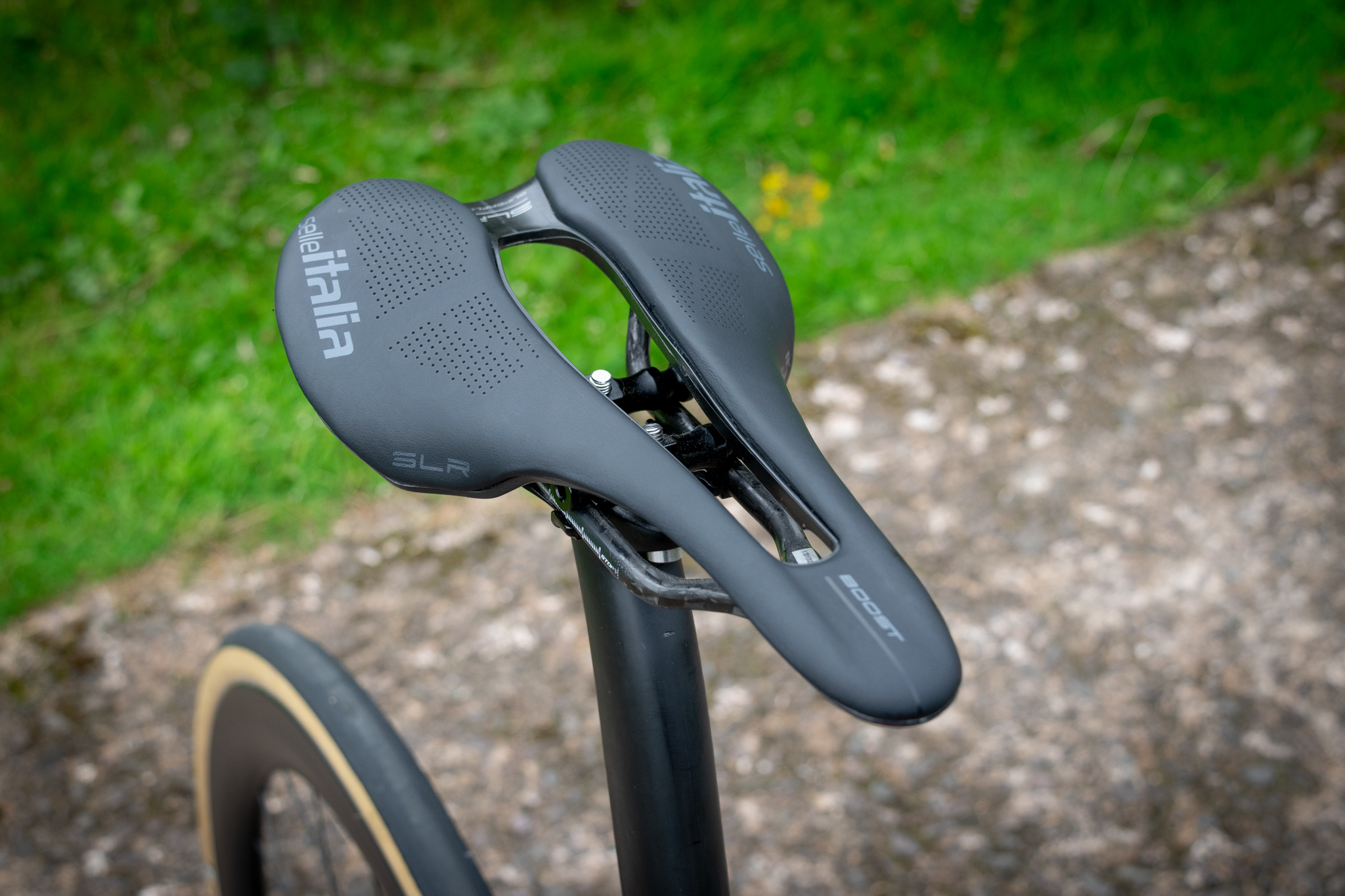
Verdict
I really enjoyed my time riding the Ridley and when my time with the bike was over I had to think hard about what my final takeaways were. It's fast and engaging to ride, and seems to do everything very well but no one thing jumped out and smacked me in the face.
This does align with the brief from Ridley though claiming the Falcn is a do-it-all all bike and I'd be inclined to agree. I'd happily race on it and can imagine myself doing so, but I'd have no qualms riding a 100-mile epic or putting bigger tyres on and tackling some more challenging terrain or (whisper it) light gravel.
I haven't had a single negative experience with the Falcn, visually it looks great and there are a range of paint options available to suit the tastes of most I'd imagine. With the sloping frame and decent saddle-to-bar drop it looks aggressive and fast and just like a race bike.
It's a fast bike, particularly on the flat and rolling terrain and rolling along at speed or freewheeling the bike carried speed very well and I feel like that's where it shone. Check the geometry is going to work for you, but if it does you won't go wrong with the Falcn, it's pretty rapid but delivers its speed in a balanced, user-friendly way.
| Design and aesthetics | CFD and wind tunnel testing design. My heritage paint scheme looked great and there are custom options available | 9/10 |
| Build | A high spec generally with di2 or AXS groupset options and premium wheels and tyres | 8/10 |
| Performance | The Falcn is a really quick bike that will be at home racing a crit or riding a sportive | 8/10 |
| Weight | An 825 gram medium frame and 7.4kg build is in the ballpark for most lighter disc brake equipped bikes | 8/10 |
| Value | A solid spec, I think most people would like a power meter included for the money though | 7/10 |
| Overall | Row 5 - Cell 1 | 80% |

Tom joined the Cyclingnews team in late 2022 as a tech writer. Despite having a degree in English Literature he has spent his entire working life in the cycling industry in one form or another. He has over 10 years of experience as a qualified mechanic, with the last five years before joining Cyclingnews being spent running an independent workshop. This means he is just as happy tinkering away in the garage as he is out on the road bike, and he isn’t afraid to pull a bike apart or get hands-on with it when testing to really see what it’s made of.
He has ridden and raced bikes from an early age up to a national level on the road and track, and has ridden and competed in most disciplines. He has a keen eye for pro-team tech and enjoys spotting new or interesting components in the wild. During his time at Cyclingnews, Tom has already interviewed some of the sport's biggest names including Mathieu van der Poel, Tadej Pogačar and Alberto Contador. He's also covered various launches from brands such as Pinarello, Ridley, Specialized and more, tackled the Roubaix Challenge sportive aboard his own rim-brake Cannondale SuperSix Evo, tested over 20 aero helmets in the wind tunnel, and has created helpful in-depth buying advice relating to countless categories from torque wrenches to winter clothing.
